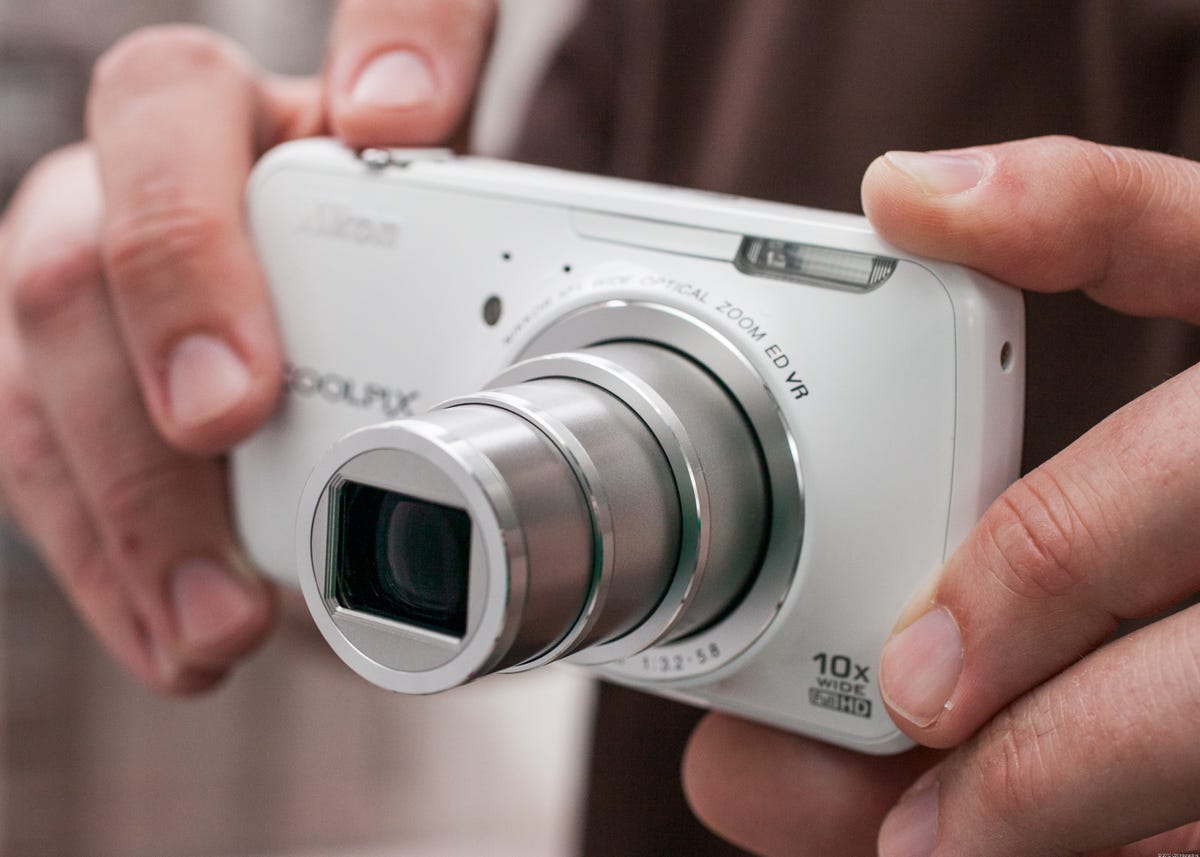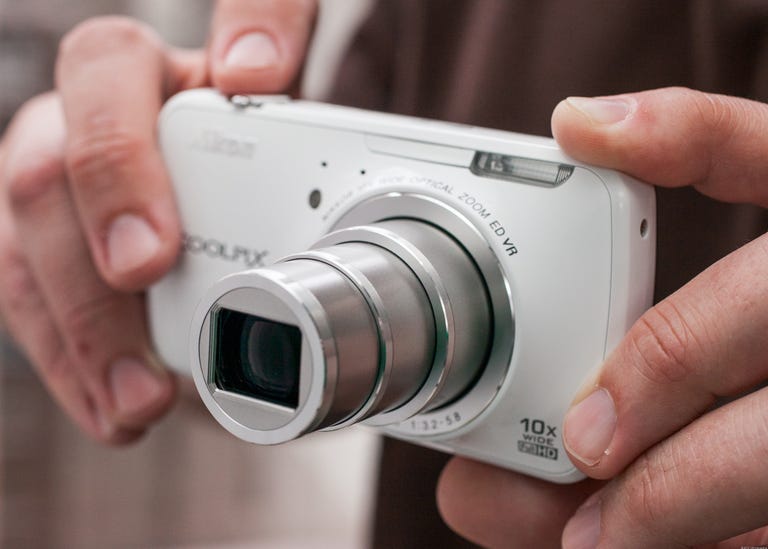 Why You Can Trust CNET
Why You Can Trust CNET Nikon Coolpix S800c review: First Android point-and-shoot misses mark
It's a good idea, but the execution could have been better.
It was only a matter of time before a major camera manufacturer started using Android as the operating system for a camera. Nikon made the jump first with the Coolpix S800c.
The Good
The Bad
The Bottom Line
There was the Polaroid SC1630 announced at CES this year, but that wasn't much of camera and it doesn't appear to be available for sale. The S800c, on the other hand, has a 1/2.3-inch 16-megapixel backside-illuminated CMOS sensor, a Nikon Expeed C2 processing engine, and a 10x f3.2-5.8 25-250mm lens with optical image stabilization -- all the stuff you'd find in Nikon's Coolpix S6300. So, yes, this is a real point-and-shoot camera running on Android.
Android does bring some fun stuff to the table, of course, with a whole world of apps at your fingertips. Although the camera doesn't have a headphone jack, it does have Bluetooth, so you can connect wireless headphones or speakers and use the camera to play games, listen to music, and watch movies. It is Wi-Fi only (there's no mobile broadband access), so while you can share directly from the camera to any of your favorite sites, you'll need to have wireless access to do so. If you're on the go, though, Nikon does have mobile apps for Android and iOS, which allow you to send to a smartphone or tablet that you could then use to upload.
My main issue with the S800c, though, is that it's not a better camera simply because it's running Android. The S6300 I mentioned earlier is currently available for about $150, and at that price, it's a decent camera. The S800c is about $350, and while that adds Android, Wi-Fi, GPS, and a touch screen, the camera itself isn't anything special.
Picture quality
Forgetting about the Android part of this camera for the moment, overall photo quality from the Nikon Coolpix S800c is above average for a point-and-shoot with its features, suitable for prints up to 8x10 or slightly larger and Web use. You will get better photos (and videos, for that matter) from it than from a smartphone, barring top models like the Samsung Galaxy S3, HTC One X, Nokia 808 PureView (and probably the Lumia 920), or iPhone 5. Even against those, it's better in low light.
Though its sensitivity settings run from ISO 125 to ISO 3200, the S800c is best used with plenty of light to keep sensitivity below ISO 400. Regardless of sensitivity, photos can appear somewhat soft and benefit from sharpening with photo-editing software. There's a Fixed Range Auto option that will limit you to ISO 125-400; I recommend using it in daylight when possible.
The two highest ISOs -- 1600 and 3200 -- should only be used in emergencies, mainly because the colors get very washed out and the noise reduction makes subjects appear smeary and flat, and actually, colors are so bad at ISO 3200 you probably shouldn't use it at all.
Video quality was very good; it actually appeared to be slightly better than the results I got from the S6300, which is nice. You do get use of the optical zoom while recording and there is an option for continuous autofocus. You may, however, hear those picked up by the camera's stereo mics in quieter scenes.
Performance
Editors' note: We recently updated our testing methodology to gauge slightly more real-world performance, so the results aren't necessarily comparable with previous testing. Until we're finished refining our procedures, we will not be posting comparative performance charts.
The shooting performance for the camera is slightly better than it is for the S6300, which is good because that camera is pretty quick. The camera will start in whatever interface you were last in, so if you turn off the camera while in the Nikon camera interface, it takes on average 2.4 seconds from off to first shot; otherwise you'll be greeted with an Android lock screen when you turn on. Shutter lag -- the time from pressing the shutter release to capture without prefocusing -- in bright conditions was 0.2 second. For lower-contrast targets, the camera could take up to 1.9 seconds to focus and shoot. Shot-to-shot times averaged 1.5 seconds without flash and 1.6 seconds with, which is excellent for a point-and-shoot.

The S800c can capture three-shot bursts at 7.9 frames per second. However, focus and exposure are set at the first shot, so if your subject is moving, chances are good all three shots won't be in focus. The camera also has 60fps and 120fps bursts; the former captures up to 25 images at a resolution of 1 megapixel, and the latter grabs up to 50 VGA-quality shots at a press of the shutter release. There's a substantial wait while the camera stores all those photos, but if you're trying to capture a specific moment in time, this is your best bet with this camera. Also, with all of these modes, the focus, exposure, and white balance are set with the first photo. If you have a fast-moving subject, like someone running, there's a good chance your subject won't be in focus for all of the photos.
So overall, shooting performance is very good. However, the rest of the camera's performance is somewhat sluggish. Apps, outside of Nikon's camera interface, are slow to open and using them isn't any better. During testing there were several times where apps would force close or hang. I was also frequently greeted with a "Please wait..." message when turning the camera on or off. It was not unlike using an inexpensive Android smartphone from two years ago. To top it off, battery life is poor (more on that in the next section).
Design and features
The S800c from the front doesn't look all that different from Nikon's other S-series models, though its casing is plastic instead of metal. Turn it around and you're looking at very nice and responsive 3.5-inch OLED touch screen and three buttons: Menu, Home, and Return. It looks like a smartphone, and since Nikon trimmed out the screen in silver, the S800c feels like a camera that's basically had a smartphone tacked on the back instead of feeling like one complete product.
That feeling extends to the camera's use, too. When you turn on the camera, you're greeted with what looks like a typical camera interface, albeit one designed for touch navigation.
Press the Menu button and you'll get settings for the camera features. However, touching the Home button will launch you into an Android home screen with various shortcuts to launch apps, including ones labeled "Shooting" and "Play" that bring you back to Nikon's camera interface. It makes complete sense that the camera features are reached using what's essentially Nikon's camera interface as an Android app, but there's something about it that's just off.
| Key specs | Nikon Coolpix S800c |
|---|---|
| Price (MSRP) | $349.95 |
| Dimensions (WHD) | 4.4x2.4x1.1 inches |
| Weight (with battery and media) | 6.5 ounces |
| Megapixels, image sensor size, type | 16 megapixels, 1/2.3-inch BSI CMOS |
| LCD size, resolution/viewfinder | 3.5-inch OLED touch screen, 819K dots/None |
| Lens (zoom, aperture, focal length) | 10x, f3.2-5.8, 25-250mm (35mm equivalent) |
| File format (still/video) | JPEG/H.264 AAC (.MOV) |
| Highest resolution size (still/video) | 4,608x3,456 pixels/ 1,920x1,080 at 30fps |
| Image stabilization type | Optical and digital |
| Battery type, CIPA rated life | Lithium ion rechargeable, 140 shots |
| Battery charged in camera | Yes; wall adapter (included) or computer via USB |
| Storage media | SD/SDHC; 1.7GB internal |
| Bundled software | Software Suite for Coolpix (Windows/Mac) |
The S800c is running on Android 2.3.3 Gingerbread, a version of the OS released in February 2011. For those with Android 4.0 or later devices, the S800c will feel immediately outdated. On the other hand, the OS is easy to use and you can do all the things you'd expect such as add shortcuts and widgets for your favorite apps, add e-mail accounts, and easily type in account information with a full onscreen keyboard.
Unfortunately, the OS and hardware don't run all that efficiently on the small battery pack Nikon used. Even just shooting automatic pictures using Nikon's camera interface, the S800c can only get up to 140 shots per charge. Do anything else such as use the Wi-Fi or GPS, play a game, record video, or stream music or video and it'll be dead pretty fast. The battery is removable at least, so you can buy extras, but you'll probably want to get an external charger, too, since the battery is charged by USB in-camera (with a proprietary 8-pin Micro-USB cable, no less).
| General shooting options | Nikon Coolpix S800c |
|---|---|
| ISO sensitivity (full resolution) | Auto, 125, 200, 400, 800, 1600, 3200 |
| White balance | Auto, Custom, Daylight, Incandescent, Fluorescent, Cloudy, Flash, Manual |
| Recording modes | Auto, Scene auto selector, Scene, Special effects, Smart portrait, Subject tracking |
| Focus modes | Face priority, nine-area auto, manual with 99 focus areas, center, subject tracking, touch |
| Macro | 4 inches (wide) |
| Metering modes | Multipattern, Center-weighted (when using up to 2x digital zoom), Spot (digital zoom of 2x or more) |
| Color effects | Nostalgic sepia, High-contrast monochrome, High key, and Low key |
| Burst mode shot limit (full resolution) | Three shots |
One of the things that bugs me about the S800c is that its shooting options don't really go beyond what you can get with any other basic point-and-shoot or current high-end smartphone. But, if you have no interest in controlling shutter speed and aperture, the S800c is for you. There are two Auto modes on this camera. One is Nikon's Scene Auto Selector, which adjusts settings appropriately based on six common scene types. If the scene doesn't match any of those, it defaults to a general-use Auto. Then there is a regular Auto mode, which is basically the Program mode you'd find on other cameras. It'll handle shutter speed and aperture settings, but you can also adjust things like ISO and white balance.
There are 17 scene modes like Landscape and Portrait as well as modes for correcting backlit subjects, easy panorama photos (180 or 360 degrees), and handheld night shots. A separate Special Effects mode gives you some creative options like High-contrast Monochrome and High and Low key. The playback menu also has other effects filters you can apply after you shoot, like soft focus for a toy camera look and fish-eye, but this matters less on this camera because you do have Android apps.
Again, the main reason it's nice to have Android is for the large number of photo and sharing apps. Something to be aware of, though, is that when you're using Android apps, you're limited to the capabilities of those apps. For example, almost all of the camera apps I tested would not allow you to control the zoom lens; only digital zoom was available. Similarly, if the editing app you're using doesn't support full-resolution edits, that won't change. And even if it does support them, it may not support the 16-megapixel images from the Nikon. Also, while I didn't run into any problems running some of my favorite apps, performance wasn't exactly fast because I'm pretty sure the camera's guts are that of a nearly two-year-old smartphone.
Conclusion
Unless you absolutely love the idea of having a point-and-shoot with a 10x zoom lens that also has access to Android apps, I would skip the Nikon Coolpix S800c. At least until the price comes down. Right now, you're better off getting the Coolpix S6300 (or another ultracompact megazoom) and an Eye-Fi wireless SD card.


